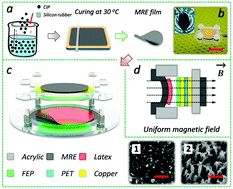Magnetorheological elastomers enabled high-sensitive self-powered tribo-sensor for magnetic field detection†
Abstract
The monitoring of the magnetic field is the most significant process for academic or industrial applications. In this study, we design a self-powered magnetic-field sensor based on the magnetorheological elastomer (MRE) and triboelectric nanogenerator (TENG) that can be used for both time-varying and uniform magnetic field (UMF) sensing. This TENG-based magnetic-field sensor (TMFS) relies on contact electrification and electrostatic induction of TENG to generate an electrical signal in response to the magnetic-induced deformation of MRE without using an external power supply. Enabled by the unique sensing mechanism and excellent magnetic-induced deformation of MRE, the TMFS exhibits a fast response (20 ms) and good magnetic-field sensing performance. The TMFS with 60 wt%-MRE shows a maximum sensitivity of 16 mV mT−1 of the magnetic field ranging from 40 to 100 mT experimentally, and the sensitivity and detection range of TMFS can be adjusted by several parameters of the device. Besides the contribution to the effective detection of UMF, this novel sensor provides a new idea for the magnetic-field measurements in self-powered mode.

- This article is part of the themed collection: Research selection from the NCNST


 Please wait while we load your content...
Please wait while we load your content...